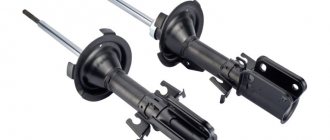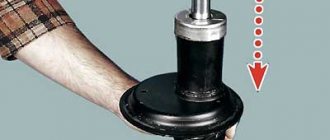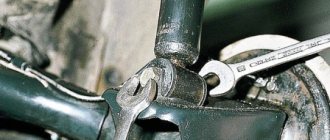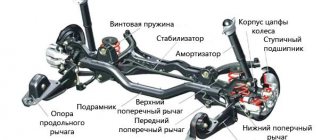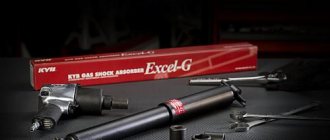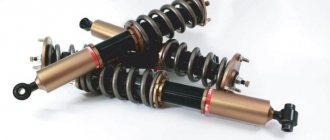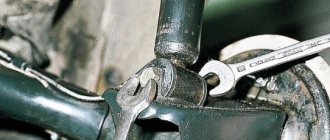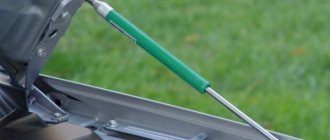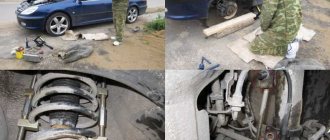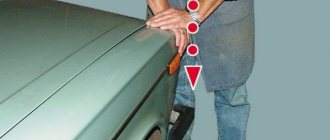What is needed to pump racks correctly
Any shock absorbers need to be pumped:
- front and rear,
- new and contract,
- one- and two-pipe,
- collapsible and non-collapsible.
The pumping process is not difficult. No special tools required. Just gloves will be enough to protect your hands from injuries and dirt. First, you should familiarize yourself with the general rules for its implementation:
- after completing the procedure, until the very moment of installation in its place, it is necessary to keep the part vertically - otherwise air may again get into it;
- It is important to consider the need to drain oil from some shock absorbers.
Shock absorbers can be either single- or double-tube, and there are also struts with a remote chamber.
Draining can be done in different ways:
- by sinking the piston into the lower component of the part (there should be an undercompression of approximately 3 cm);
- through a groove designed for this purpose - it is usually present in the upper part of the part.
Why do you need to pump?
All new shock absorbers are stored in a lying position, this is convenient and does not take up much space.
A compensation tank is structurally provided inside the product where oil can drain when it is in a horizontal position.
Therefore, if you install a shock absorber that is not pumped, then, as a rule, knocking noises appear immediately or after a while; after a couple of thousand kilometers, working fluid may leak. This is what many inexperienced car owners sin on.
Therefore, the idea is to, after pumping, return the working fluid to the cavities provided for it, and then leave the device in a vertical position until installation, so that overflow does not occur again.
You also need to understand that you can buy shock absorbers, each of which has been in the warehouse for a certain time and this time can vary greatly.
Therefore, you should not worry if the forces exerted on each of them during pumping, as well as the speed of movement of the strut rod to the reverse position, may differ - this is normal.
You also need to understand that if, for example, two shock-absorbing struts on the left or right sides fail, then all devices must be replaced at once, otherwise the car may rock while driving.
Bleeding shock absorbers: step-by-step instructions
An important element of the suspension of a modern car is the shock absorber. This component of the chassis is also called a shock absorber strut. It provides a comfortable and safe car ride. It is entrusted with the task of damping body vibrations and softening impacts when driving on the road.
Before installing a new shock absorber on a car, it is pumped. Incorrect preparation leads to rapid failure of the rack. Bleeding will help identify a manufacturing defect and replace the rack under warranty. This article will help you find out what a shock absorber strut is and how to properly bleed it?
How to properly bleed a shock absorber before installation: instructions and technology
If it comes in handy, here it is for you:
1. Of our domestic hydraulic oils, AMG-10 is still better; it is intended for use in aircraft hydraulics. And as you probably know, even modern passenger aircraft fly at altitudes of about 9000 m with year-round outside temperatures of -40 and below. That is, this oil works normally at such low temperatures. Where can I get it? ... well, think for yourself.
When using the AMG-10, there are pros and cons (figure out the pros and cons for yourself, this is a very personal matter):
- it is guaranteed to be of high quality, its characteristics are stable and do not depend on manufacturers ();
- the racks don’t “wrinkle” in the cold, well, there is no effect of a cart on wheels at sub-zero temperatures (in my opinion);
- the car becomes softer, more comfortable (I have a family car, in my opinion, but for GTechnicians this is a thing);
- not all seals tolerate this oil (maybe they do, but I use Japanese ones, so there are no problems with them). I check durability in the simplest way - I take a small jar, fill it with AMG and throw in the oil seal intended for the next replacement. Before “throwing” I measure the dimensions of the oil seal. The holding time is long - my last “repair kit” has been soaking for six months now, they just don’t seem to snot, they hold their geometry and it’s easier for me to keep them in a jar of oil until the next repair than to take them out, scrub and rinse them and store them somewhere. And so they lie quietly in the oil in a twisted mayonnaise jar. There was one case of instability, but these were our, domestic seals.
2. It’s not for me to teach you how to pump and expel air from the inner cylinder. But many people forget about flushing the rack with kerosene, which means an internal cylinder and a piston. I almost forgot, if the struts have already completely died and they have already been “punched” to the point of a characteristic knock, then most likely the valves on the piston are already broken. Then repairing the rack is more of a complacency, it will not work normally. They need to be changed or the valves need to be changed, along with the piston.
3. Do they solder the nipple away from the camera? Well, this is not our method.
You can, of course, make it simpler, drill a hole in the outer cylinder and insert a short nipple from a tubeless camera there (you’ve probably already met, there is a standard - long nipple, and there is a short one). I’m not asking the question of how to pump the same pressure into both racks, this is, in principle, more or less realistic - from one compressor-receiver it is simultaneously supplied to both racks and is turned off when the required pressure is reached. Unfortunately, less, because the pressure difference will still be due to the nipples. And do you know why? The fact is that the nipple opens at a certain difference in pressure at the inlet and outlet. This pressure difference is determined by the nipple spring, and it is different on each nipple, well, just a little, but different. Taking this into account, it turns out that we supply the same pressure to the input, but at the output we will get a different one. And if we also take into account the small volume of the pumped cavity... in general, the real difference is approximately 0.3 atmospheres. That is, the racks will turn out different. Well, besides, when driving, the pressure in the stand can reach tens of atmospheres. Forgive me, a sinner, but the nipple is not designed for this. He will simply start poisoning. For these reasons, I refused nipples.
And also interesting: LADA 4×4 Urban 5 doors. 2022: photos, prices, configurations, characteristics - AVTOVEK: LADA dealer in Yekaterinburg (Sverdlovsk region)
True, now I drive simply repaired ones, without “supercharging”, and you would be right in calling all of the above theorizing. Just rummaging around in all this near-column, another idea for the same “supercharging” appeared. Unfortunately, I haven’t done this on my stands yet (well, somehow they still run like that), so I think it’s too early to share my experience.
4. Often they do not replace the entire rack, but put it in the old cartridge. In this case, the inner cylinder with the piston is removed and the same cartridge is inserted into the outer cylinder. There is one subtlety here that is often forgotten and because of this the cartridge dies earlier than it could; death occurs most often in the summer.
So, when the cartridge is already inserted, then you need to pour any oil, even waste oil, into the cavity between this same cartridge and the wall of the old rack. And the point of this is that by placing the cartridge in the rack without oil, we get something like a thermos. The cartridge will heat up when driving; between it and the outer wall there is air, which is known to be a poor conductor of heat, i.e. the cartridge will not be able to transfer heat anywhere, it will heat up, heat up, and overheat to the point of failure. When we pour oil into this wall, the heat from the cartridge through the oil will be transferred to the outer wall and dissipated into the nature around us.
How to bleed oil
Bleeding oil structures has some peculiarities. The process itself is performed strictly in accordance with the presented algorithm.
- The part is installed with the rod down and after that it is necessary to smoothly compress the shock absorber itself until it stops.
- After compression is completed, follow for 2-3 seconds. leave it in this position without ceasing to hold it.
- Without releasing the rod, you should turn the part over - for no more than 6 seconds. you should leave it in a compressed position (during this time all the air should come out).
- The next stage is to extend the rod all the way.
- Next, the shock absorber will again need to be turned down with the rod and pause for no more than 3 seconds.
Usually you should do at least 3 approaches in accordance with the designated algorithm. The optimal number of such approaches is 6. Regardless of the total number of approaches, you should perform a control action on the third one.
It is performed as follows.
- The shock absorber is turned upside down.
- Sharp, short movements are made to compress the rod.
Its progress must be smooth, without jerks or any failures. If there are no problems, you can begin installing the shock absorber in place. It is not necessary, but it is advisable to replace shock absorbers in pairs. If possible, you should familiarize yourself with a video guide on how to carry out such a procedure in advance.
How to upgrade new kayaba struts
ATTENTION! A twin-pipe shock absorber that is not pumped before installation is a common cause of failure of the shock absorber piston system. This is a violation of the installation instructions and a possible reason for a non-warranty case! If air remains in the inner liner of the shock absorber, the shock absorber may not perform its function properly. Failure to operate leads to noise, knocking when the shock absorber operates and its possible failure.
We recommend service station technicians to bleed the shock absorber two to three times before installation. This allows you to identify cases of stuck valve mechanism, as well as other cases of valve mechanism malfunction. We also draw your attention to the fact that small dips in the resistance of the valve mechanism, as well as the difference in the speed of the rod exit in gas-oil shock absorbers, are not a malfunction and in no way affect the operation of the shock absorber.
Before installing a twin-tube shock absorber on a car, it must be brought into working condition. During transportation and storage in twin-tube shock absorbers, working fluid can flow from the inner to the outer cylinder, and boost gas or air enters the inner cylinder. In this case, the shock absorber will make knocking noises when operating in the car’s suspension, and its throttle valves will be destroyed. To avoid damage to the shock absorber, it MUST be brought into working condition (pumped) before installation.
All shock absorbers are pumped in the same position in which they are installed on the car, vertically. After pumping, the shock absorber should be in the working position, vertical, until it is completely installed on the car.
Please note that some shock absorbers are equipped with oil drain mechanisms. In some shock absorbers, to drain the oil, the rod is provided to fall into the shock absorber, after which the oil is removed from it. In other shock absorbers, a special technological groove is made at the very top of the rod. Therefore, when bleeding the shock absorber, we recommend not fully compressing the shock absorber. The shock absorber rod should remain 2-3 cm uncompressed (the working surface of the rod should not reach the top of the strut cup by 2-3 cm), and if there are technological grooves, it should be compressed to them.
Technology for pumping McPherson struts and cartridges:
A. Install the stand or cartridge with the rod up and smoothly, without jerking, compress it to a certain point (the working surface of the rod should not reach the top of the stand glass by 2-3 cm);
B. Fix the shock absorber rod in this position for 2-3 seconds;
B. Smoothly pull the rod until it is fully extended;
D. Repeat operations A, B, C 2-3 times;
D. Holding the shock absorber vertically, with the rod up, perform a control operation (with sharp but short movements of the rod, make sure that the piston moves smoothly, without failures). In well-pumped shock absorbers, the piston moves smoothly without dips (please note that in some shock absorbers, when fully decompressed, the valve mechanism may enter the compensation cavity, designed to expand the shock-absorbing fluid when warmed up, and not provide any resistance).
One of these days I’m planning to rebuild the front suspension, so I decided to refresh my memory on some issues. One of them is the correct pumping of shock absorbers... I don’t pretend to be original - the following text was taken from the “Open Knowledge Base on Nissan Cars”, from the instructions of the same name
Read also: Oka stalls when you press the gas
Instructions: correct bleeding of KAYABA EXCEL G shock absorbers
Good afternoon friends!
Maybe someone will find these instructions useful for properly pumping Kayaba Excel G shock absorbers (twin-pipe gas shock absorber). Text translated from original Kayaba installation instructions
ATTENTION ! Failure to bleed a twin-tube shock absorber before installation is a common cause of failure of the shock absorber piston system. This is a gross violation of the installation instructions and a likely reason for the case to be out of warranty! If there is residual air in the inner liner of the shock absorber, the shock absorber will not perform its function properly. Malfunctions lead to knocking, noise during operation of the shock absorber and its possible failure. New shock absorbers from the factory may have air bubbles in the shock absorber piston system.
Based on long-term experience, the company's designers and engineers have prepared recommendations for pumping the shock absorber:
Before installing a twin-tube shock absorber on a car, it must be brought into working condition. During storage and transportation, in twin-pipe shock absorbers, liquid can flow into the outer cylinder from the inner one, while gas enters the working cylinder (inner). In this case, its throttle valves will be destroyed and the shock absorber will produce extraneous noise and knocking when operating in a car suspension. To avoid shock absorber malfunctions, it must be pumped before installing it on the car. For this:
1. The shock absorber should be turned upside down and compressed slowly, without sudden movements;
2. In this position, the shock absorber rod must be fixed for 2-3 seconds;
3. Without releasing the rod, you need to turn the shock absorber over with the rod facing up, and fix the shock absorber in this position for about 3-6 seconds;
4. After 3-6 seconds and leaving the shock absorber in a vertical position, smoothly extend the rod until it stops (end of stroke);
5. Next, you need to position the shock absorber with the rod down, pause for 2-3 seconds. and repeat operations of points 1, 2, 3, 4 approximately 5-8 times;
6. When bleeding the shock absorber, following the entire above sequence, stop at step 4;
7. Holding the shock absorber in a vertical position, with the rod up, perform the last, let’s call it, a control operation (with sharp movements you need to press the shock absorber rod a little at a time and with proper pumping, the piston should move smoothly and without failures). If the shock absorber is pumped correctly, the piston moves smoothly, without dips.
After pumping is completed, the shock absorber must be kept in the working position, VERTICAL and ROD UP, until final installation on the vehicle. After bleeding, under no circumstances should the shock absorber be tilted or turned over before installation.
Many people install a shock absorber directly from the box, without proper bleeding; in this case, the life of the shock absorber is reduced by 3-5 times, and the shock absorber cannot perform its functions normally (does not work correctly)
ps You might notice that if the shock absorber was inoperative for a long time (stored) in a lying position, the rod may move with jerks and shocks.
Read also: Electric fuel pump for VAZ carburetor
I will be glad if this instruction helps someone, I think not everyone here installs an expensive original, if you follow these instructions you will really notice a positive effect. Good luck on the roads!
Replacing shock absorbers is a complex, multi-step procedure. Improperly installed shock absorbers wear out faster, operate ineffectively, and even lead to loss of controllability. To prevent this from happening, we have put together this guide.
